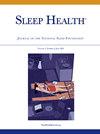Late-life sleep medication use associated with increased falls risk in the Atherosclerosis Risk in Communities (ARIC) study
IF 3.4
2区 医学
Q2 CLINICAL NEUROLOGY
引用次数: 0
Abstract
Objective
Accidental falls are the leading cause of injury for older adults in the United States. Identifying risk factors for falls is a public health priority. Poor sleep is prevalent among aging adults and has been linked to falls risk. We examined late-life sleep medication use and falls risk in a cohort of older adults.
Methods
The Atherosclerosis Risk in Communities (ARIC) study is an ongoing community-based cohort study. ARIC participants taking any barbiturates, benzodiazepines, antidepressants, non-benzodiazepine receptor agonists, or other hypnotics in the past 4 weeks (2011-2013) were categorized as taking a medication that affects sleep, regardless of indication. Participant hospital discharge records were reviewed through 2019 for ICD codes indicating incident falls. Propensity score matching was used to match participants who used sleep medications with those who did not (1:2). Cox proportional hazards regression models were used to assess the association of sleep medication use with falls with adjustment for demographics, lifestyle, and health characteristics.
Results
In the matched sample (N = 4794; 70% female; mean age 75.5 ± 5 years), 1200 documented falls occurred over 6.5 years of follow-up. In fully adjusted models, sleep medication use was associated with a 33% greater risk of falls compared to nonuse (HR: 1.33; 95% CI: 1.18-1.51). Results did not differ by age, sex, depressive symptoms, baseline cognitive status, or physical functioning status (interaction p-values >.05).
Conclusions
Late-life sleep medication use is associated with a higher risk of falls. Further research is needed to clarify the mechanisms linking sleep medications to falls risk.
在社区动脉粥样硬化风险(ARIC)研究中,老年睡眠药物使用与跌倒风险增加有关。
目的:意外跌倒是美国老年人受伤的主要原因。确定跌倒的危险因素是公共卫生的优先事项。睡眠不足在老年人中很普遍,并与跌倒风险有关。我们研究了一组老年人的晚年睡眠药物使用和跌倒风险。方法:社区动脉粥样硬化风险(ARIC)研究是一项正在进行的社区队列研究。在过去4周内(2011-2013)服用任何巴比妥类药物、苯二氮卓类药物、抗抑郁药、非苯二氮卓类受体激动剂或其他催眠药的ARIC参与者被归类为服用影响睡眠的药物,无论其适应症如何。审查了截至2019年的参与者出院记录,以查找显示事故跌倒的ICD代码。倾向评分匹配用于匹配使用睡眠药物和不使用睡眠药物的参与者(1:2)。使用Cox比例风险回归模型评估睡眠药物使用与跌倒的关系,并对人口统计学、生活方式和健康特征进行调整。结果:匹配样本(N = 4794;70%的女性;平均年龄75.5±5岁,在6.5年的随访中发生1200例跌倒。在完全调整的模型中,与不使用睡眠药物相比,使用睡眠药物与33%的跌倒风险增加相关(HR: 1.33;95% ci: 1.18-1.51)。结果不受年龄、性别、抑郁症状、基线认知状态或身体功能状态的影响(相互作用p值>.05)。结论:晚年使用睡眠药物与较高的跌倒风险相关。需要进一步的研究来阐明睡眠药物与跌倒风险之间的联系机制。
本文章由计算机程序翻译,如有差异,请以英文原文为准。
求助全文
约1分钟内获得全文
求助全文
来源期刊

Sleep Health
CLINICAL NEUROLOGY-
CiteScore
6.30
自引率
9.80%
发文量
114
审稿时长
54 days
期刊介绍:
Sleep Health Journal of the National Sleep Foundation is a multidisciplinary journal that explores sleep''s role in population health and elucidates the social science perspective on sleep and health. Aligned with the National Sleep Foundation''s global authoritative, evidence-based voice for sleep health, the journal serves as the foremost publication for manuscripts that advance the sleep health of all members of society.The scope of the journal extends across diverse sleep-related fields, including anthropology, education, health services research, human development, international health, law, mental health, nursing, nutrition, psychology, public health, public policy, fatigue management, transportation, social work, and sociology. The journal welcomes original research articles, review articles, brief reports, special articles, letters to the editor, editorials, and commentaries.
 求助内容:
求助内容: 应助结果提醒方式:
应助结果提醒方式:


